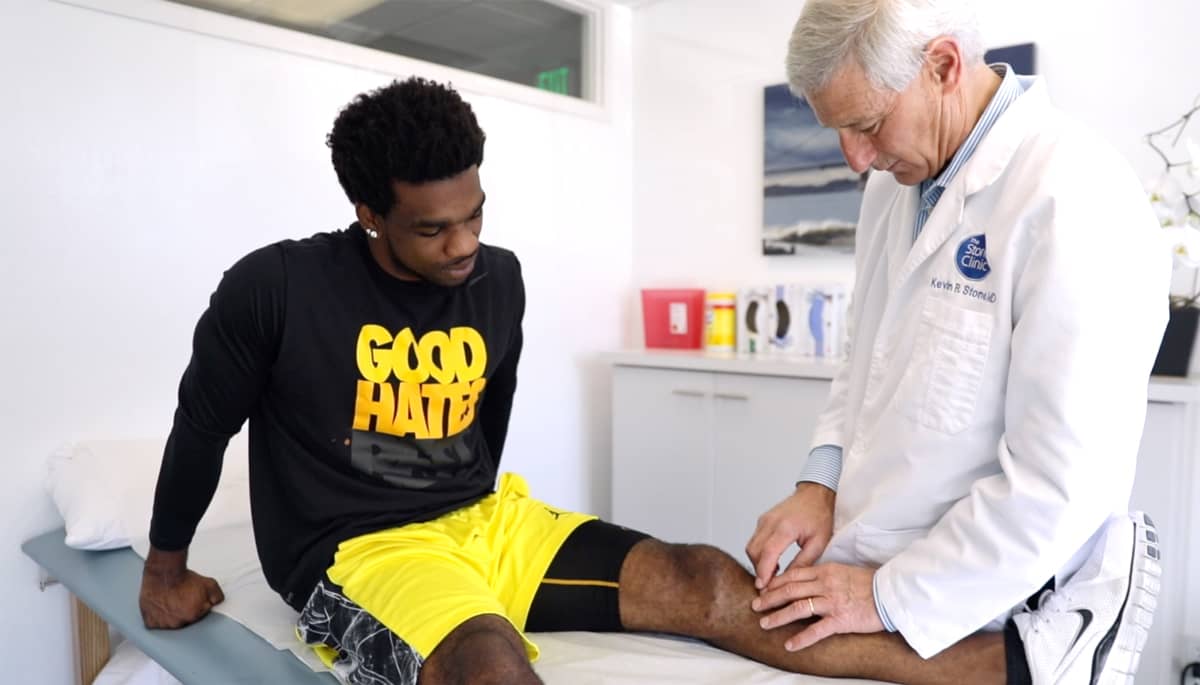NFL = ACL Injury
The NFL season is upon us—and while it is fun for us, it is devastating for many knees. Here is the most current data.
 Dr. Stone performing knee injury examination on Super Bowl-winning NFL cornerback Tracy Porter
Dr. Stone performing knee injury examination on Super Bowl-winning NFL cornerback Tracy Porter
The ACL connects the femur to the tibia and is vulnerable to a multitude of sports-related maneuvers. When ruptured it heals poorly, leading to knee instability, meniscus tears, and arthritis. The reconstruction techniques to replace the ACL are mostly split into two strategies. The first requires taking tissues from the patient’s own body, thereby creating a second injury. The other involves taking donor tissue from young healthy donors who often have unfortunately died, often from motorcycle and gunshot accidents. Surgeons use whichever approach works better in their hands. We almost always use donor tissue from the patella or quadriceps tendon.
In either case, there is a significant failure rate and a high incidence of subsequent knee arthritis after ACL injury and surgery. The field of ACL replacement is in dire need of better ligament replacement choices and techniques. And to complicate matters, avoiding these injuries is elusive; the ACL injury prevention programs shown to be effective for female athletes do not appear effective with NFL football players.
Recently published data (ref Palmieri-Smith et al AJSM 2021:4997):1786-1793;) demonstrated an average of 62 ACL injuries in the NFL season per year. The most vulnerable players were those relatively new to the NFL, with 75% of the ACL injuries happening to players with less than three years experience. Training camp is also risky, with 40% of the injuries occurring during the first four weeks of preseason. While 281 ACL injuries occurred from 2015-2019 during the preseason and regular season, only five occurred during the same period in the post-season.
Special teams like punt returns were especially risky, with 24% of all ACL injuries happening during the game. Running backs were the next most prone to the injury. Sixty percent of all the ACL injuries occurred during games, possibly due to the high intensity of play. These injuries were spread out evenly across the four quarters and did not increase over the course of the season, which makes them less likely to be due to fatigue.
The arthritis risk for NFL players from ACL injuries alone is 50%—which means that fully half of the players who have an ACL injury will develop arthritis, usually within 10 years after the injury. If the meniscus tissue is also damaged, the arthritis rate increases dramatically. One bright spot here is that our research, and that of others, appears to indicate that feeding the knee with lubricants and growth factors after injury may be helpful in reducing the degradative process that begins after an injury.
While NFL football is not alone in having a high ACL injury rate (ski racing, rugby, and soccer also hold these honors), the amount of money involved, the massive size of the musculature, and the fitness level of the players should have generated an intense effort to solve the ACL rupture problem. Unfortunately, it has not—and while we cheer for our athletes, we mourn their injuries. Next time, as we all know, it could be our knee.
Hear the patient experiences of those who've undergone Dr. Stone's ACL reconstruction in here in our video library.

